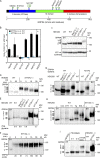Quantitative glycoproteomics reveals new classes of STT3A- and STT3B-dependent N-glycosylation sites
- PMID: 31296534
- PMCID: PMC6683751
- DOI: 10.1083/jcb.201904004
Quantitative glycoproteomics reveals new classes of STT3A- and STT3B-dependent N-glycosylation sites
Abstract
Human cells express two oligosaccharyltransferase complexes (STT3A and STT3B) with partially overlapping functions. The STT3A complex interacts directly with the protein translocation channel to mediate cotranslational glycosylation, while the STT3B complex can catalyze posttranslocational glycosylation. We used a quantitative glycoproteomics procedure to compare glycosylation of roughly 1,000 acceptor sites in wild type and mutant cells. Analysis of site occupancy data disclosed several new classes of STT3A-dependent acceptor sites including those with suboptimal flanking sequences and sites located within cysteine-rich protein domains. Acceptor sites located in short loops of multi-spanning membrane proteins represent a new class of STT3B-dependent site. Remarkably, the lumenal ER chaperone GRP94 was hyperglycosylated in STT3A-deficient cells, bearing glycans on five silent sites in addition to the normal glycosylation site. GRP94 was also hyperglycosylated in wild-type cells treated with ER stress inducers including thapsigargin, dithiothreitol, and NGI-1.
© 2019 Cherepanova et al.
Figures







References
-
- Braunger K., Pfeffer S., Shrimal S., Gilmore R., Berninghausen O., Mandon E.C., Becker T., Förster F., and Beckmann R.. 2018. Structural basis for coupling protein transport and N-glycosylation at the mammalian endoplasmic reticulum. Science. 360:215–219. 10.1126/science.aar7899 - DOI - PMC - PubMed
Publication types
MeSH terms
Substances
Grants and funding
LinkOut - more resources
Full Text Sources
Other Literature Sources
Molecular Biology Databases
Miscellaneous

